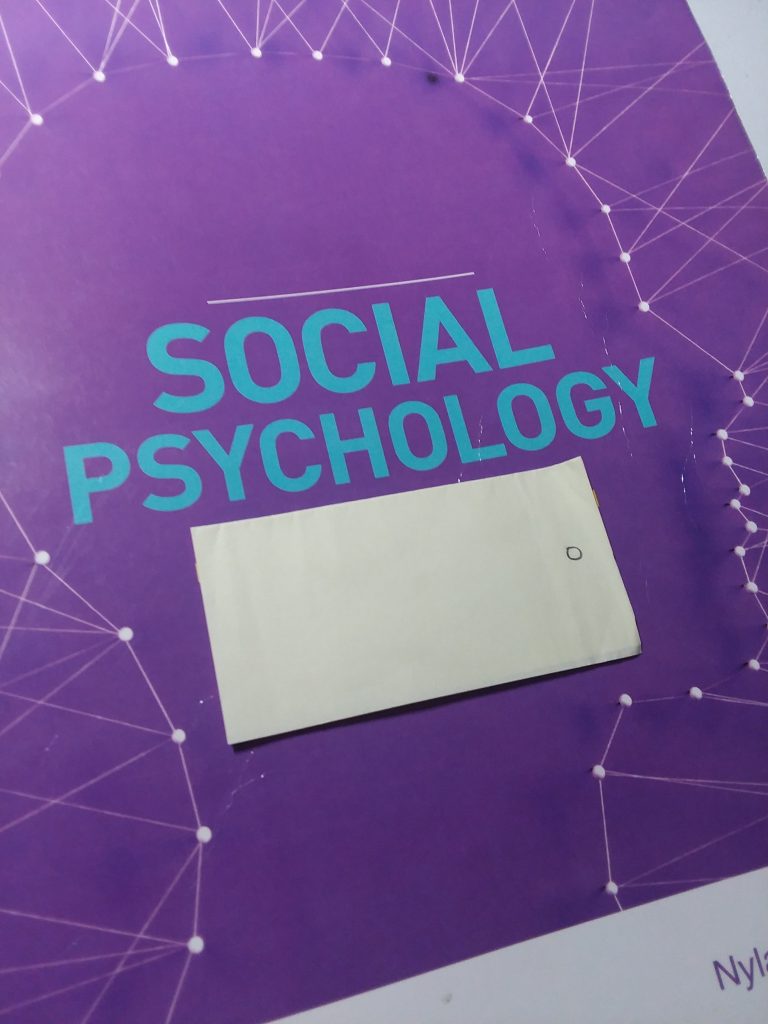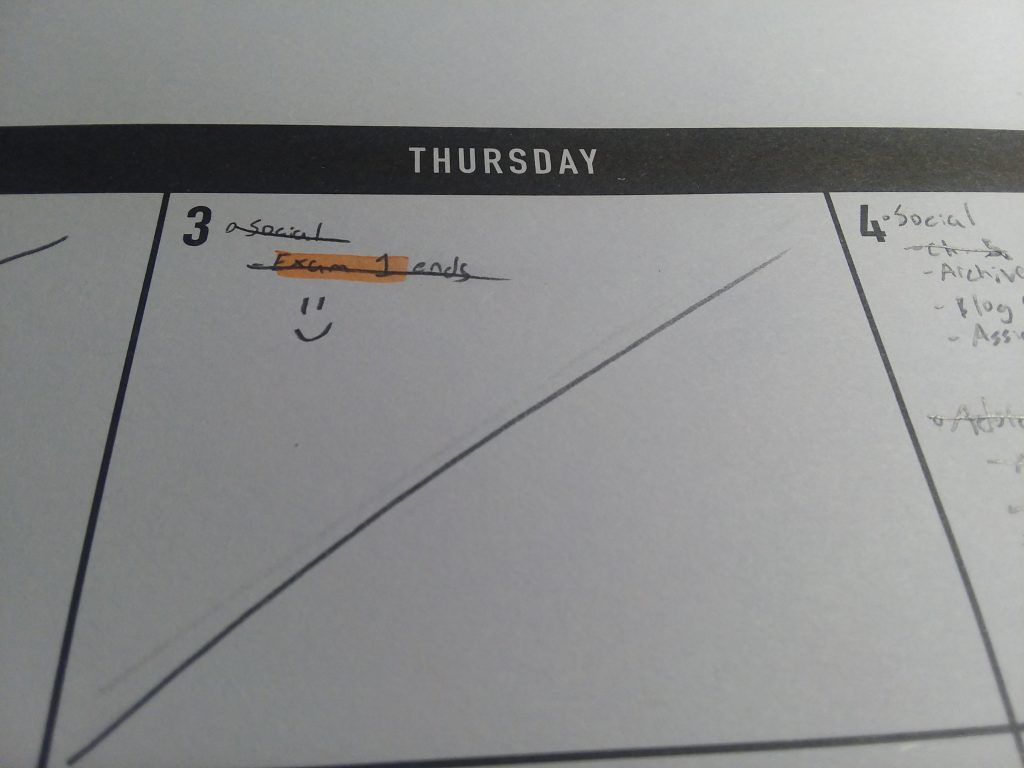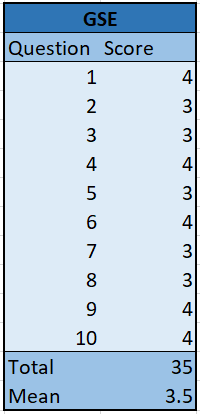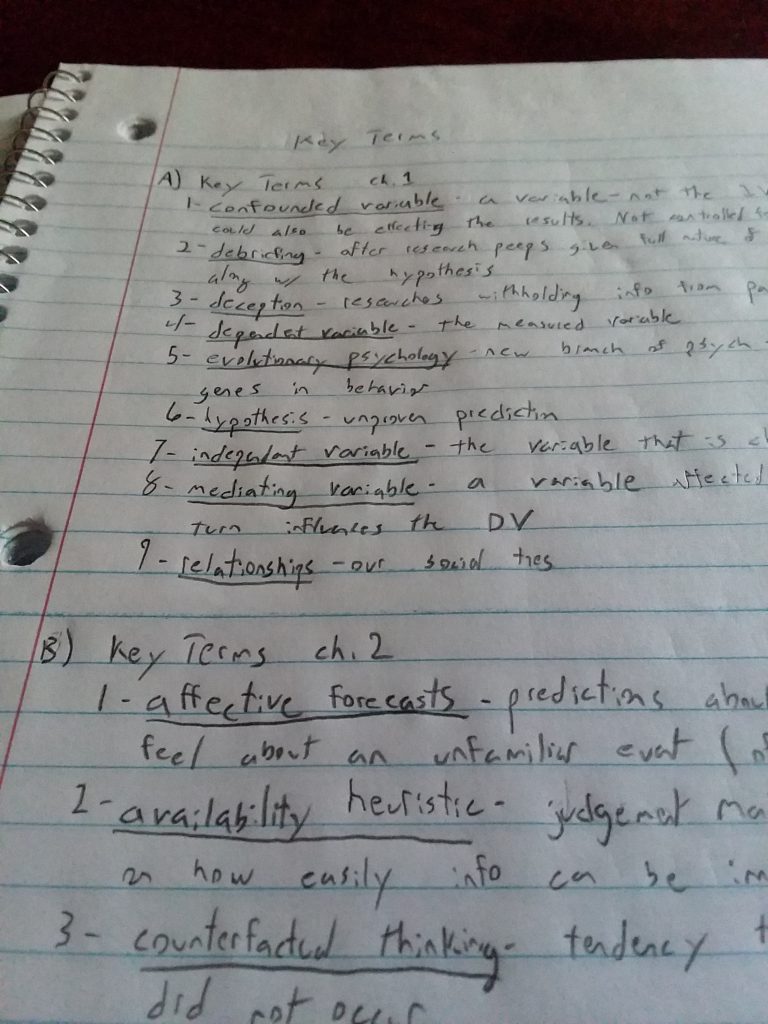Blog 10
Better understanding the processes in which people perceive each other and their subsequent interactions was what I hoped to gain from this class, and, in that regard, I achieved my goals for this class. I would say that I learned a few tips and tricks that I can apply to my own life.
While I certainly know more about the topic, I would not say that my attitude towards Social Psychology has changed any. I thought it was a neat topic before this class and I still think it is a neat topic. There is, however, one thing I would change if I were to take this class again—I would take it in a face-to-face class. Taking an online class about social interaction seems a little counterproductive 😊 It sure wasn’t fun reading about all the ways in which I should be depressed because I spend most of my time alone!
My two biggest takeaways off the top of my head are: 1) smile more because it will make me happier and will potentially make others like me more too and 2) if I act the prototype of the role I want my chances for obtaining that role will be greater.

This last picture is one for celebration. It is the bookmark I have been using for this class all semester and, now that I’m finished with the textbook, I don’t need it anymore! Although this class was fun, I’m happy to be one semester closer to graduation.
Blog 9
The top 3 things I’ve learned in this class, at least of those posted to the blog, are: 1) heuristics and the assumptions our brains make 2) the types of love and how they chance over the course of a relationship and 3) the idea of self-presentation in different contexts.
The concept of emotional intelligence, as discussed in Blog 7, relates to the idea of types of love in ATA4. Being self-aware of my own emotions no doubt helps me with my relationship with my husband. By being close to myself I can more easily be close to another.
Another course that is easy to connect Social Psychology with is the Adolescent Development class I am currently taking. The idea of self-presentation is extremely relevant to adolescents as they have a strong need for peer affiliation.

My organizational “process” for this assignment as simple—a cup of coffee! The blog is fairly short, all things considered, so it did not require much review. Plus, I wrote everything so once I saw each picture I remembered what the post was about and knew what was important to me at a glance.
Blog 8
My reaction after reading the article on heterosexual sexual conflict was—thank god I’m gay! It also makes me glad that I’m married and don’t have to worry about the dating stage of a relationship anymore. Not that we don’t have our problems, we do, but I’m glad we don’t have those problems.
Men and women frustrate each other in the mating ritual (boy, that sounds overly clinical and emotionless!) for different reasons due to evolved differences. Early in the dating process, men will pretend to be more emotionally interested than they really are. Women will as well but to a lesser degree. Women are more likely to show signs of sexual interest for gains unrelated to success. Here again, the opposite gender will do so as well but not as much.
When it comes to jealousy towards possible infidelity, men and women differ regarding whether physical or emotional infidelity would be worse. Finally, men are more likely than women to stalk their ex after a breakup.

I choose to take a picture of myself laughing because I don’t have to worry about these problems! Of course, my husband and I may fall under the typical male category presented here but without that controlled for it would be impossible to say with certainty. It is possible that males and females in same-sex relationships differ in types of sexual conflict since both partners are from the same evolved gene pool, as it were. This may change a relationship’s dynamics.
Blog 7
Emotional Intelligence is a person’s ability to understand and, to a certain extent, control his or her emotions. While we are not always able to control what emotions are felt, we can control which emotions are expressed at any given point and time. This is where self-regulation comes in. Self-regulation allows us to, well, regulate our emotions. People are both logical and emotional at the same time. With good self-regulation and awareness, we can reduce our tensions so we can make more rational decisions and not let our emotions lead our behaviors unchecked.
The most import part of emotional intelligence, to me, is being aware of the emotions of others. Since people are emotional creatures, if I can tell what mood someone is in, I am in a better position to understand his or her behavior. If my spouse comes home angry, recognizing that quickly and trying to help can mean that the rest of my day will go more smoothly! It is simply considerate. After all, I would want the same support if I am having a bad day.
One way I use self-regulation is by simply acknowledging when I am in a bad mood. While it does not always make the feelings go away, being able to say “I am grouchy right now” is a great way to avoid arguments, I find! While I am pretty good at catching myself in a bad mood, I could always be faster at deescalating my feelings. Catching these feelings as they are rising and doing some breathing exercises may help. Unfortunately, it may be a little awkward to close my eyes and breathe for 10 seconds in certain social situations 😊

These are the results from the EQ test I took. Nothing really surprised me here, but I will say that my biggest improvement over the last few years has been in social-awareness. I have always been good at recognizing my own emotions, but I have gotten a lot better at recognizing the emotions of others.
Blog 6
My reaction to the video Killing Us Softly III with Jean Kilbourne is—sadly—yup, that’s the way of things. The portrayal of women in advertisement and media is psychologically harmful and gives developing females unrealistic expectations. Problems inevitably come along for the ride when those expectations go unrealized.
This video did not change my perception on the topic because the issue has been gaining a lot of attention in recent years, thankfully. People are becoming increasingly aware of the problem and I’m starting to see a healthy rejection of these harmful stereotypes. For example, a recent Facebook movement started of women taking pictures of their post-childbirth bellies to normalize the perception of a mother’s body. What a positive step!

These pictures from various ads were selected because each portrays a different gender stereotype. The first ad demonstrates a dangerous, and common, stereotype that pretty women are dumb and that ugly women are smart. This is something we see all the time in television and movies. The second ad shows a mother running around during the holidays doing all the housework so the family can have a nice Christmas. The third ad reinforces the stereotype that women are bad drivers by showing the mom having difficulty parking while ignoring the good advice given by the father. The fourth ad shows a woman feeling inadequate about her breast size during her wedding day (thanks to her mother in law). For the last ad I wanted to show that men face stereotype issues as well. It shows a man being a manly man and being rewarded with a manly snack.
Stereotypes exist for both genders and it’s probably not healthy for anyone to normalize unrealistic expectations.
Blog 5
1) Credible Ad

(http://www.willitblend.com)
The “Will it Blend” advertisements from Blendtec are, in my opinion, the most convincing ads I’ve ever seen. Plus, they’re fun! After watching them blend cell phones, golf balls, pens, and marbles, it is impossible to deny their claim that Blendtec is a tough and reliable blender. They achieve their credibility through entertaining demonstrations. I will say that, while credible, I have not purchased one myself since the starting price is roughly $300, but, if I were in the market for a $300 blender, I know where I would go!
2) Not Credible Ad

(https://www.nytimes.com/2017/11/01/upshot/why-advertising-is-a-poor-choice-to-tackle-the-opioid-crisis.html)
I chose this picture to represent an ad lacking credibility because it is the first ad that comes to mind when thinking about ridiculous and biased advertisement. It fails for a couple of reasons. For starters, the advertiser clearly has a vested interest as they received financial support from the government’s war on drugs campaign. Also, the ad uses fear appeals which tend to not be persuasive. Finally, who the heck doesn’t like fried eggs?
3) Attraction Appeal Ad

(https://thevisualcommunicationguy.com/2017/10/05/romance-appeal-advertising/)
This ad uses an attraction appeal since it has an attractive male and female, presumably a couple, enjoying a Coke together. Companies chose attractive people for advertisements for one simple reason: it works. Ads with attractive and likable people are more convincing overall. This ad did not work on me personally because I have not drunk a soda in almost a decade and it would take more than a cute couple to start drinking soda again!
Blog 4
Honestly, I am quite happy with my exam grade! Going forward, I intend to study for future exams the same way and hope for similar results.
Once the exam review material was made available, I went and reread the chapter sections it referred to that I did not recall as well as I wanted. Also, I reread all the key points and the chapter summaries. There is a lot of material on the exam (160 pages worth), so a complete review is not realistic, and a perfect grade is unlikely. I’m okay with that.
I spent about a week reviewing for this exam and focused on areas I felt weak in. One thing that surprised me about the exam is that most of the questions were applied concepts and not simple factual recitation. Considering this, I will try to stay more focused on the big picture and not get hung up over every research finding the book presents.

This is a picture of my calendar and the smiley face I drew after the exam to show how I felt about my results.
Blog 3
Music has always been a strong connection between me and my close friends and family. Perhaps less so now than when I was a teenager or an emerging adult, however. I feel that music plays a stronger role when we have a more difficult time expressing our feelings and find a needed catharsis in music. As I have gotten older, I no longer see music as a way of uncovering emotions unknown to me. Still, I enjoy sharing music with those that are very close to me, especially if a song reminds me of them.
I came up with the below soundtrack before analyzing any connected values. What interested me after making the list is how sad all the songs are! Melancholy, pessimism, realism—whatever you want to call it—is a shared outlook I have with many of my friends and family members. For all that, we do share many positive values. Just to name one, we are all accepting of anyone regardless of race, religion, sexual identity, nationality, political affiliation, etc… If I were to make an armchair psychologist interpretation, I’d guess that the same rejections which led to our melancholy nature is what also makes us more accepting of others. So, yes, I do see a connection between musical preferences and values.
My Soundtrack:
Spouse—”Lungs” by Townes Van Zandt
My Outlook on Life—“Mad World” by Gary Jules
Dad—”Beneath the Raven Moon” by Mary Youngblood
Mom—“Ain’t no Sunshine” by Matt Anderson
Brother—“Everyone I Love is Dead” by Type o Negative
Close Friend—“Laid to Rest” by Lamb of God

This is a picture of two Native American flutes my dad made. He spent the last 10 years of his life making flutes fulltime. We spent a lot of time together in the presence of flutes and Native American music in general, so it means a lot to me.
Blog 2
In regards to my self-efficacy—belief in one’s ability to succeed in a given situation—as a student, I am confident in my ability to do well. (Gosh, that sounds a bit arrogant, so I will add that I do not always live up to my own expectations!) My self-efficacy comes from my past experiences of doing well if I try. As an online student, I have had to be self-driven, organized, and detailed. My past accomplishments and successes have shown me that as long as I plan and stay on top of things, I will succeed.
One area that I could improve on is my ability to stick with my goals without letting anxiety creep in. No matter how well I am doing self-doubt will find its way in at times. This can, however, be a good thing! At least academically. Anxiety and fear of failure can keep me pushing forward. The downside of anxiety is, well, worrying all the time.

I choose to include an image of the table I made in Excel when completing the task because it serves as an example of my organized approach to my education.
Blog 1
The second objective, though broad in scope, is why I enrolled in social psychology above other options available for my minor in psych. How well we perceive and understand other people is a crucial skill in navigating the social sphere. People are complicate. Knowing how others perceive us as well as understanding our own biases can help us in everyday encounters. Hopefully, I’ll learn how to manipul… I mean, interact with others better! By the end of the class, I hope to learn a few tips and tricks for interacting with others and coming across the way I intend.
My strategy for success in this class is my normal approach, which has been a successful one for many a course. I do a little bit of work every day since the brain can only absorb so much knowledge at once. I turn in all my work on time and make sure to study. Nothing to it really! Just hard work and proper organization.
Image: Key Terms

The choice in this image was very deliberate. One of my weaknesses is that I do not remember key terms well; I tend to understand concepts easily but will forget or mix up new terminology. So, I make sure to study any terms carefully to help me overcome this.